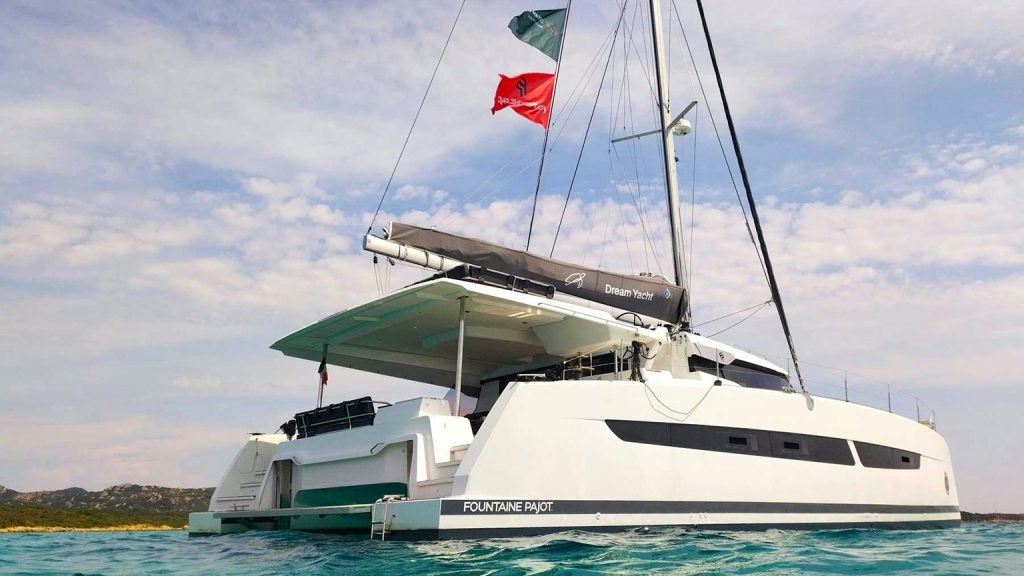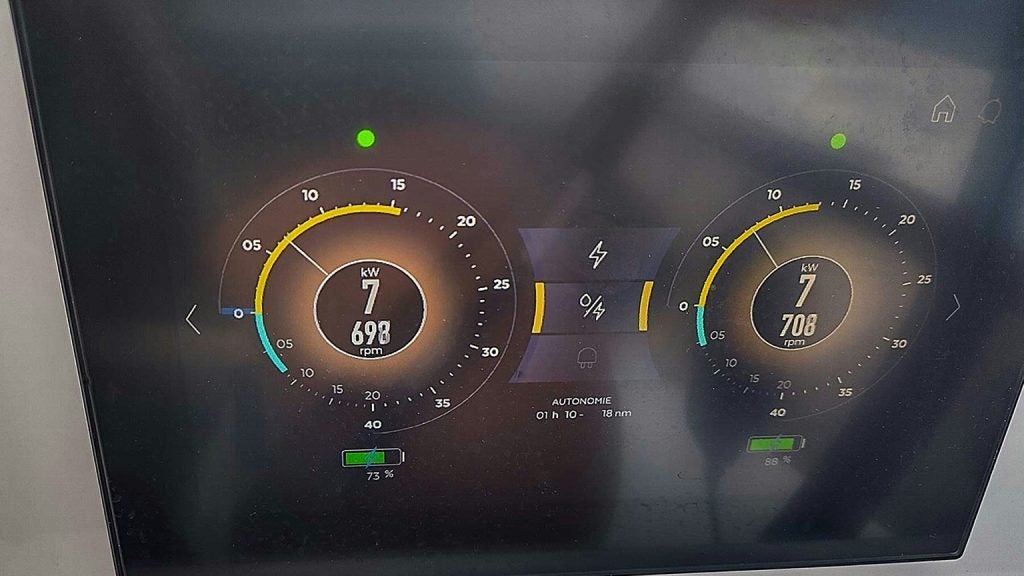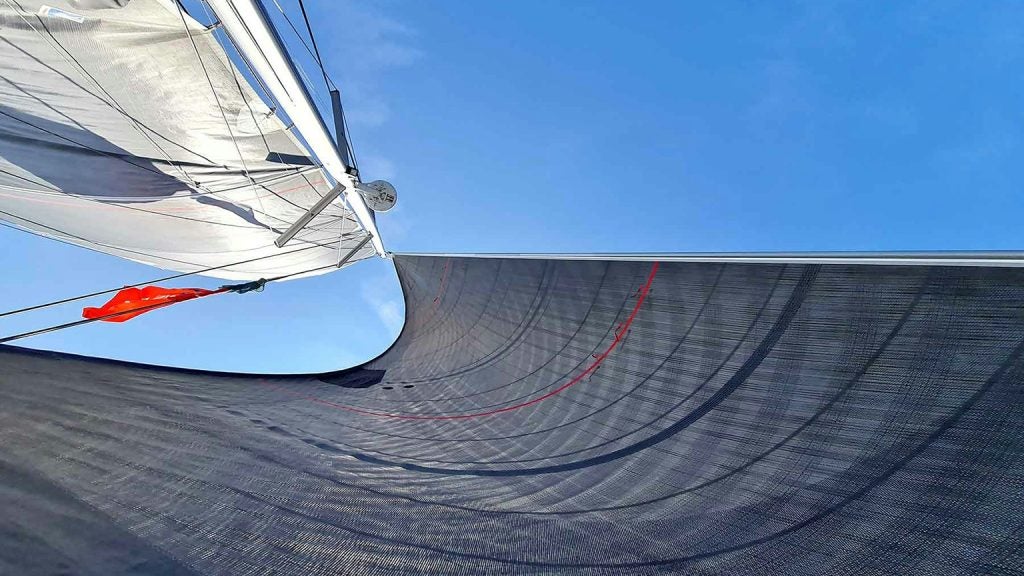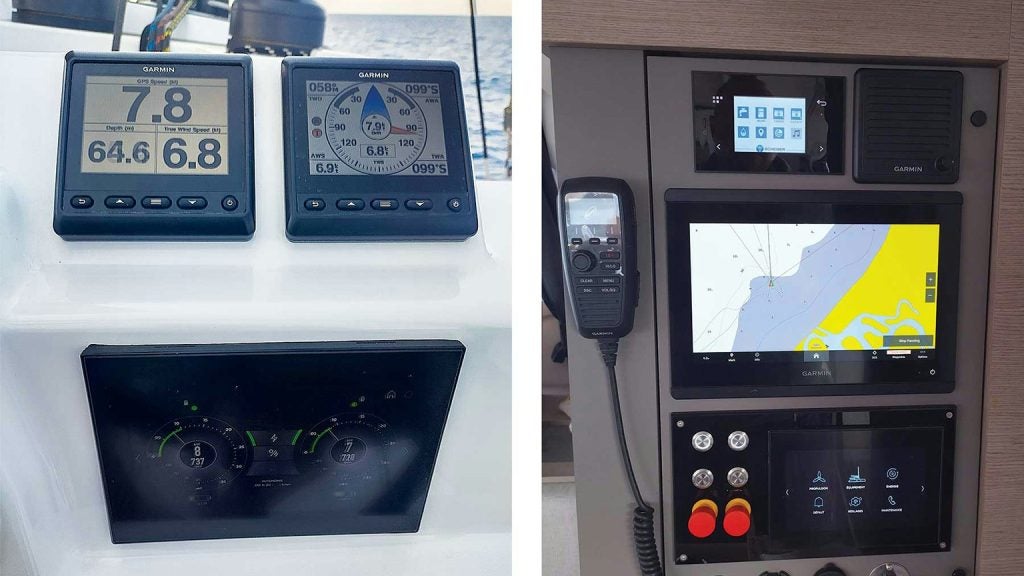
Aura 51: Technical set up & handling
Navigating with an electric motor, in silence, without vibrations or smoke, is a unique sensation – waiting to be experienced aboard the new Fountaine Pajot Aura 51 Smart Electric. This hybrid electric catamaran, rare in the charter rental world, emits, in the end, less than half of the CO2, NOX and fine particles when compared to a conventional diesel catamaran.
We have written this guide to help you understand the basics of how this particular boat model operates. This is not an instruction manual (there is one on board), but rather a series of observations and advice to help you enjoy your environmentally friendly cruise under the best possible conditions.

A very comfortable and successful catamaran
Fountaine Pajot’s new Aura 51 is a successful sailboat. It is beautiful from stem to stern, with its boom positioned at a reasonable height, its sleek and modern long hull windows – externally, it has allure that we find very seductive. Inside, it is a veritable apartment on the sea and patently comfortable, with nearly 150 m2 (1600 ft2) of usable space.
Electric Propulsion
The Smart Electric version of the Aura 51 is equipped with an auxiliary motor of a new type. On a conventional catamaran, diesel engines provide propulsion, while a diesel generator provides power for energy-intensive services.
On the Smart Electric, the two diesel engines were replaced by electric motors (28 kW) mounted on pods (external nacelles). These motors are powered by lithium batteries (2×27.7 kWh), themselves recharged by various means including a powerful generator (32 kW) capable of ensuring navigation with the electric motors and the generator in any situation, dozens of hours in a row, even when the batteries are empty. The two systems, port and starboard, are totally independent and the boat can sail on a single engine, like any catamaran. This configuration allows the boat to be used in 100% electric mode (generator off) or in hybrid mode with the generator running.
The 100% electric mode

In 100% electric mode, the boat runs on its own batteries and no longer produces any pollution. In terms of vibrations and noise, it’s night and day in comparison to a diesel catamaran, as you can only perceive a very faint rippling sound.
In this mode, relying on full batteries, you can sail three or four hours at five knots, consuming only 5 kWh per engine. It’s amazing to comprehend the small amount of power needed for propulsion at low speed for this sailboat of nearly 25 tons. At an increased speed of seven knots (15 kWh per engine), one cannot count on much more than an hour of autonomy and at top speed, 8.5 knots, less than 45 minutes!
The hybrid mode

When the electric motor’s battery charge level reaches 20%, the Aura 51 will automatically start the powerful diesel generator, without any intervention from you. You can also choose to start it manually.
Placed in a soundproof cocoon and installed in a perfectly insulated compartment, its operation goes practically unnoticed while navigating. The perceived noise level is nothing like that of a diesel catamaran; it is much, much quieter. The generator will then adjust its speed according to the engines’ operating needs to minimize fuel consumption.
The running generator is capable of maintaining a cruising speed of 7 knots as long as there is diesel fuel on board (1000 L). Depending on the chosen speed and instantaneous power consumed by the engines, the generator can also recharge the batteries while ensuring continued propulsion of the boat.
If we have been sailing and the batteries are empty, it will only take two or three hours with the generator running to fully recharge the propulsion batteries. We can go ashore for dinner and the generator will automatically stop once the batteries are recharged.
Recharging the batteries

Hydro-generation
Electric motors have an interesting ability: when sailing with the engines off and the propellers spinning, they can generate electricity. This is called hydro-generation. The propeller starts to spin in reverse and drives the motor, similar to how an electric car brakes or a bicycle dynamo works. On this well-tuned boat under sail, hydro-generation can charge the batteries at a rate of about 3 to 4 kW per hour.
It is possible to increase or decrease hydro-generation by adjusting the lever of the motors placed in hydro-generation mode. Overall, hydro-generating slows down the boat’s speed under sail by about one knot. We lose one knot, but gain kilowatts. In this position, the motors work and produce a perceptible noise, different from that produced when running forward.
Shore Charger
While the yacht is docked, of course the batteries can be charged using shore power. Two powerful shore chargers allow for fully recharging the boat overnight.
Understanding the energy system onboard the Aura 51 Smart Electric
On board this boat, there are two types of energy systems. Firstly, the two electric propulsion systems, and secondly, a 12 V network for comfort services.
The 220 V (air conditioning, water heater, power outlets) is converted from the high-voltage system batteries. With full batteries, the boat is capable of running its air conditioners on the propulsion batteries throughout the night without a generator.
The 12 V powers the lights, refrigeration unit, electronics, Tenderlift system, and watermaker.
At night, the 12 V system recharges from the propulsion system if it is left in service. If the propulsion system is completely turned off, communication with the 12 V batteries and production of 220 V is cut off.
Tracking energy onboard the Aura 51 Smart Electric

All energy data is displayed on two screens dedicated to propulsion. One is located in the cockpit and the other at the helm. These screens display energy production from different sources (generator, shore power, hydro-generation, solar) as well as showing energy usage by various consumers (motor, 12 V, 220 V). The displays make it possible to monitor the solar charging and the power used by the motors in real-time.
The electronic dashboards also facilitate switching between 100% electric mode, hybrid mode (with generator), or even to hydro-generation. It is not necessary to become an expert in energy management on this boat because when the batteries are low, the generator starts and stops automatically as needed. Of course, the generator can also be stopped manually.
Navigating with the engine on the Aura 51 Smart Electric
The handling is quite similar to that of a diesel engine, only the levers are smaller and respond more delicately. There is no difference in port maneuvers which are always done using the thrust of each motor. The response times and behavior in reverse are identical.
The display differs from that of a diesel engine’s tachometer. On the Smart Electric display, once the electric propulsion is engaged (a combination of buttons to be pressed), propeller revolutions are shown, but it is mainly the instantaneous power of each motor that interests the skipper.
One of the basic laws of electricity establishes that battery capacity in kWh is determined by multiplying operating power by duration, so autonomy depends on the power used and becomes THE central data. Autonomy, in hours and nautical miles, is always clearly displayed and updated in real-time.
Optimizing the autonomy of the engine
Aboard the Aura 51, minimizing the use of the generator quickly becomes a sport! To excel at it, one must optimize sailing phases, preferably downwind, which are the most conducive to energy production through hydro-generation.
When sailing under power, it’s best to only lightly engage the motors. At 5 knots, you can cover approximately 20 nautical miles while at 7 knots, you won’t go beyond 8 nautical miles. In light winds, you can provide additional motor support of 2 x 2 kW to help the boat. This support quickly gains an extra 2 knots without heavily impacting autonomy.
In hybrid mode, it is best not to allocate all of the generator’s 32 kW to power the engines but rather reserve a power range for simultaneously charging the propulsion batteries. By navigating with both engines running at 2 x 8 kW, speeds exceeding six knots can be achieved while delivering equivalent power for battery charging.
The impact on fuel consumption and emissions
With only one diesel engine on board instead of three, along with renewable energy sources, there is a noticeable impact on fuel consumption. Electric motors are more efficient than internal combustion engines. This is why an electric motor with 50% less power than a diesel engine is still sufficient to propel this type of boat.
A conventional catamaran of this size consumes between 15 and 20 liters of diesel per hour when using the engine, not including the generator’s consumption. The Aura 51 Smart Electric consumes less than 10 liters per hour when its generator is running.
In terms of fuel cost, an electric sailboat like the Aura 51 Smart Electric is significantly more fuel-efficient than a traditional catamaran. With a single diesel engine (the 32 kW generator) instead of two diesel engines (55 kW x 2), the consumption of the Aura 51 Smart Electric is half that of the conventional version. During a week of navigation with 30 hours of motoring, approximately 200 liters of diesel can be saved, depending on speed.
This translates to a bill of $450 for the Smart Electric compared to double that amount, $900, for the conventional version.
Over the course of a week-long cruise, this amounts to savings of 200 to 300 liters of diesel, or between 6,000 and 10,000 liters per year and between 33,000 and 55,000 liters over the course of the yacht’s total duration in our fleet. Saving 55,000 liters of fuel is equivalent to not emitting14 tons of CO2 (equivalent to eight round trips between Paris and New York), reducing NOX emissions and avoiding significant production of fine particles (PPM).
__________________________________________________________
Experience the quiet freedom of electric yacht ownership! Contact our professional Yacht Consultants to learn more the electric hybrid yachts available, and our Go Green Incentives program.
